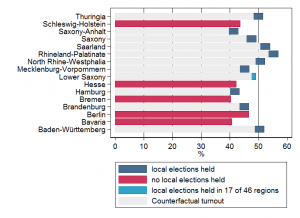By Arndt Leininger, PhD candidate, Hertie School of Governance, Berlin
What is the story?
As pointed out in a preceding blog entry, in Germany, the turnout rate at the 2014 European election was higher than at the preceding 2009 European election. The overall difference is of 4.8 percentage points (from 43.3% in 2009 to 48.1% in 2014).
Many political observers explain this increase by to the fact that local elections and referendums were held on the very same day in several local entities. Local elections were held in 11 out of 16 German states, while there was a state-wide referendum in Berlin. In this entry, I bring further evidence confirming the existence of a causal relationship between the simultaneity of local elections and a high turnout rate at the European election using official election returns and demographic/socioeconomic data.
Association between simultaneity of local elections and turnout
As reported in Figure 1, the turnout rate at the 2014 European election in Germany varied quite drastically from one state to the other. The first observation one can make is that the turnout is higher in nearly all the states where simultaneous local elections (or a simultaneous state-wide referendum as in Berlin) were held. It is important to note that the subsequent analyses were conducted in considering that no simultaneous local elections were held in Berlin. The results presented hereafter can thus be considered as conservative estimates of the effect of simultaneous elections on turnout in European elections.
A simple comparison of turnout rates between states with and without local elections reveals a statistically significant difference of 5.8 percentage-points: 49.6% on average for states with simultaneous local elections (excluding the state of Lower Saxony where local elections were only held in a few local entities) and 43.8 for states without them. When I use more fine-grained disaggregated data, i.e. at the sub-state “regional” level, I find an even more striking difference of 8.9 percentage points (50.9% v/s 41.9%).
Figure 1: Turnout rates at the 2014 European elections in Germany (state level), click to enlarge
In order to more precisely estimate the effect of simultaneous local elections on the turnout rate at the 2014 European election, I ran random intercept models regressing the turnout rate at the regional level by whether or not simultaneous local elections were held in the region, and adding control variables such as population density, the proportion of people receiving unemployment benefits, local business tax revenues (as a proxy of wealth) and the proportion of high school graduates. The coefficient of interest remains relatively unaffected by the inclusion of these controls: The turnout rate at the European elections is 3.2 percentage-points higher in regions where simultaneous local elections were held (significant at a level of 0.05).
What would have been the turnout rate without local elections?
Based on these estimations, it easy to calculate what would have been the turnout rate at the European election if the local elections were not held the very same day. To do so, I subtract the average effect of 3.2 percentage points from all regional turnout rates. Then, based on actual population figures, I calculate what would be the number of voters under this scenario. The results are shown in Figure 1: 46% of Germans (instead of the actual 48.1%) would have shown up to the polling stations if there were no local elections held the very same day.
Confirming causality
The observation that the simultaneous organization of local elections is associated with higher turnout rate does not forcefully mean that there is a causal relationship between the two. A better test of this causal statement is to check whether the simultaneity of local elections effect remains after controlling for the turnout rate at the previous European election in 2009. However, even when I add this extra variable in the regression presented above, this effect remains largely unchanged (and is still statistically significant at a level of 0.05). What is more, in the 3 German states (Brandenburg, Hamburg and North Rhine Westphalia) where simultaneous local elections were held in 2014, while not in 2009, the results demonstrate that the turnout rate increased by 10 percentage points in these three states.
Concluding remark
A quick analysis of the election returns at the regional level suggests that the fact of holding a local election the very same day increased turnout at the European election by about 3 percentage points. Without these simultaneous local elections, federal turnout rate would have been around 2 percentage points lower. As demonstrated in a previous blog entry, this effect is highly relevant politically speaking, as low turnout seems to have benefited the Eurosceptic party AfD.


2 Comments
States that did not hold local elections in 2009: Brandenburg, Hamburg and North Rhine Westphalia. Berlin held a referendum which it did not in 2009. My quick analysis outlined above auggests a three percentage point increase due additional elections in the three states. Another way would be just looking at what the turnout increase in the three states translates to at the national level.
Nice! One question that came to my mind: Yeah, national turnout is 46%, when we control for local elections. But just by how much has it increased, from 2009? In 2009 there were also about the same amount of local elections, but in other states. Especially local elections in North Rhine Westphalia should have a huge impact on national turnout rate, since it has by far the largest population. So, what is the turnout rate in 2009 controlling for local elections at that point in time? I would imagine that the increase in turnout since the 2009 election is not as high as 48-43 would make us believe…